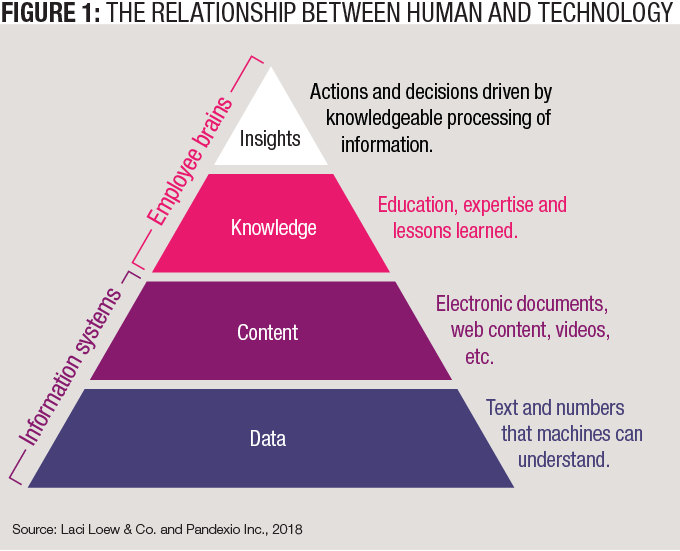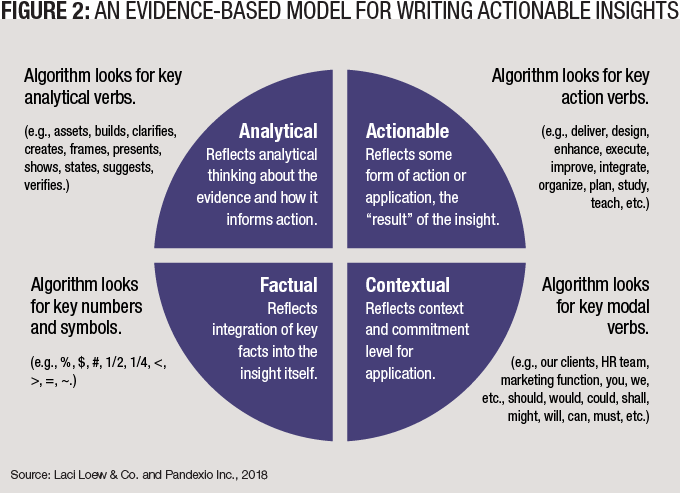
Addressing the missing link between content, insight and wisdom curation, and critical thinking.
by Laci Loew, John Burge, Bob Danna
August 29, 2018
Content curation is not a new phenomenon. For decades, employees have attempted to collect and sort information, and management has sought to derive associated quantitative business value — largely to no avail. The challenge has always been how to separate the signal from the noise or, in other words, the actionable 2 percent from the rest.
But how do you meet that challenge? Insight curation may be the answer.
Overlooked Aspects of Insights
Insights have been referred to as the new currency of business, and today’s economy is often referred to as the insight economy. Consultancies and think tanks have made it clear: To compete today, companies must rely on critical-thinking experts sharing insights.
In fact, insight-driven organizations are growing at an average of more than 30 percent annually and are on track to earn $1.8 trillion by 2021, according to “Insights-Driven Businesses Set the Pace for Global Growth,” a 2017 report by Forrester Research Inc. As such, we must implement and operate networks of insights. Big data and business intelligence are not enough. The path to action lies in insights, and insights come from human expertise.
What does this mean for the average employee? What is the human aspect of extracting business value from information? Is their role limited to setting up the processes and machines that spit out numbers and charts, or do we rely on the minds of humans to form the insights as a result of information they consume? If insights are to be digitally shared with peers for assessing them, collaboratively determining actions or making decisions, or increasing business valuation, does a person need to reduce their insights to writing?
The answer is yes — and that means they need the skills to author effective, high-quality insights.
Value Starts With Critical Thinkers
Creating high-quality insights requires critical thinking. Leaders everywhere seek critical thinkers. Advertised job postings have doubled since 2009 according to analysis by Indeed.com, and a 2016 Davos World Economic Forum report lists critical thinking as No. 2 (behind only problem-solving — a requisite critical thinking skill) in the top 10 skills for the global economy in 2020.
Why the urgent and growing need for critical thinking? In an interview with Forbes for a 2017 article, “How to Hire and Develop Critical Thinkers,” William T. Gormley Jr., professor at Georgetown University, said: “Today’s global and interconnected society is exposing us to more different people, with different views and mounting amounts of new information. We need tools but also the human capability to sift through it all and evaluate everything coming into our lives. And it’s not just about assessing this or that argument. We also need critical thinking to help set priorities and be adaptable to all the change coming at us.”
Critical thinking may also be the key to closing the wisdom gap in business today. In a 2014 HuffPost article, “Thinking Matters: Critical Thinking Is Crucial for Success,” James Martin from Oxford University said, “A serious problem right now is the gap between our skill and our wisdom. Today, deep reflection about our future circumstances is eclipsed by the rush to build faster, cheaper, smarter, more-efficient gadgets. Society’s best brains are saturated with immediate issues that become ever more complex, rather than reflecting on why we are doing this and what the long-term consequences will be.”
To succeed in business, we must do better than consume content. We must contemplate, evaluate, synthesize and apply the content we consume. In other words, critical thinking is no longer just “nice to have” — it is a business differentiator. What separates high-progress organizations (those that get better business results than their lower-performing peers) will be the extent to which their employees are purposeful about questioning the status quo, igniting wonder, creating insights and sharing their wisdom across the enterprise. Insights will be the new measure of business success — the new “currency of business,” according to Forrester Research.
What Makes Insights Actionable?
Insights reflect complex thought processes, which means they are not synonymous with raw data or information but rather are the output of critical thinking. As such, humans are necessarily involved in forming insights.
While data, information and content often come from machines and computers, only humans are capable of complex thought processes for the foreseeable future, notwithstanding advances in artificial intelligence (see Figure 1). Thus, information and content fuel the formation of insights in the minds of employees but in and of themselves are not insights.

Insights are actionable when they are aligned, contextual, relevant, specific, novel and clear.
- Alignment: Insights are more likely to drive action when they are closely tied to key business goals. Aligned insights have a direct relation to business performance metrics (growth of intellectual capital, employee engagement, financial return, sales growth, customer satisfaction, talent turnover, productivity) that you control and influence.
- Context: Insights shaped by experience, background, benchmarks or other comparison data generally promote action. Ample supporting evidence ensures the insight does not morph into opinion, unwarranted skepticism or objection and encourages action, innovation, creation and problem solving.
- Relevance: Insights are actionable when readily accessible and consumed by the right people in the right amounts when needed. If insights are buried in knowledge repositories or traditional learning management systems or learning experience platforms and not accessible via digital workplace platforms and devices that enable critical thinking, they may never make it to those in need.
- Specificity: Succinct, explicit insights that offer “why” with evidence to prompt more inquiry drive immediate action.
- Novelty: Innovative and provocative insights that stand out beyond the 24/7 information flow with which employees are overwhelmed are compelling. Insights that gain the curiosity of those who should be paying attention and challenge the human mind get acted on much more frequently than those that simply reinforce what we may already know.
- Clarity: Clearly communicated insights expressed in a single tight, cogent sentence with empirical reference pave the pathway for action.
The more insights line up with these attributes, the more actionable they will be and the greater the value they will offer your business.
Authoring Actionable Insights
Authoring and sharing actionable insights are long-overdue critical thinking skills that are essential for the future workforce. We spend more than $150 billion per year training employees on routine information and manual tasks. However, when it comes to insights — the most basic building block of critical and systems thinking and among the top skills needed for the future workforce — we provide little enablement, if any. In fact, until now, few have even thought about curated insights, focusing instead on content curation, which often does not produce a single insight.
The writing of actionable insights is a critical thinking skill that matures with practice and generally occurs over four phases:
- Consuming content to fuel thinking.
- Identifying relevant and specific nuggets of evidence aligned with a problem to be solved (the beginning of critical thinking).
- Collecting the evidence nuggets at a topical level, ensuring contextual appropriateness (an intermediate level of critical thinking).
- Connecting the evidence nuggets and sharing a clear, innovative and informed insight in a cogent sentence to accelerate problem resolution (expert critical thinking).
Fortunately, authoring actionable insights can be learned. Writing effective insights starts with understanding the foundation on which they are built. There are three foundational elements of every great insight: evidence — information nuggets one encounters (content consumed); knowledge — the things one knows (education, expertise and lessons learned); and context — what one is paid to do (role, function, company purpose).
An evidence-based model (Figure 2) has been developed for incorporating these foundational elements into an algorithm for scoring digitally curated insights for actionability. A baseline factor in the model is length, with the Twitter limit as an upper bound for scoring. In addition to length, there are four components representing specific word types that reflect insight actionability based on the foundational elements: analytical thinking about the evidence, application of the evidence, integration of empirical evidence, and context and commitment level of the application or action.

Measuring Business Value
Following are examples of high-quality, high-scoring actionable insights that incorporate empirical data/facts, analytical verbs, modal verbs and action verbs — the word types used by the insight value algorithm. These words are italicized.
- A 20 percent rate of IT turnover suggests our HR group might examine flight risk in our IT department.
- The 25 percent increase in harassment allegations implies our leadership should rectify existing violations.
- The finding that 30 percent of worker tasks can now be automated requires us to re-evaluate our 2018 staffing plan.
To present easily understandable feedback to insight authors, the model reduces algorithm results to a point-based scale ranging from 1 to 5, with 1 being the least actionable and 5 the most actionable. Algorithm weighting factors are optimized by manually comparing the perceived actionability of more than 100 insights to their scores (selected from a database of several million insights based on permissions). Insights are then rewritten and rescored based on the model and manually compared a second time to assess perceived actionability based on revised scores.
This scoring system seeks to achieve four outcomes. The first two are short-term, focused on improving human performance: (1) identification of the most actionable, well-formed insights for better-ordered search results facilitating the surfacing and sharing of expert insights and knowledge, and (2) offering feedback to insight creators to help them create more effective and actionable insights going forward.
The third and fourth outcomes are more long-term, focused on leveraging the digital power of insight curation and critical thinking platforms. As countries around the world transition from knowledge-based economies to the era of the expert and the insight economy, it is increasingly important that we develop systems and methods for (3) scaling human expertise, and (4) delivering evidence-based content to a wider community via the coming together of humans thinking critically and technology enabling the sharing of human insights.
The scoring system is not intended to rate insights as valid or invalid but rather as more or less actionable. If people do not clearly understand an insight, why it is important and how it can help them, the insight will be overlooked and forgotten. Writing insights effectively is important to their adoption, fruition and use.
As cognitive systems continue to strip away routine knowledge work, expert critical thinkers will play an increasingly valuable role in driving business actions and decisions. A key to enabling this value is the curation and sharing of well-crafted insights. Such insights represent intellectual capital that increases overall business value.
John Burge is CEO and co-founder of software platform Pandexio. Bob Danna was a managing director in the Human Capital practice at Deloitte Consulting LLP until he retired in 2017. Laci Loew is a human capital analyst, consultant and executive vice president of marketing at Pandexio. They can be reached at editor@CLOmedia.com.



